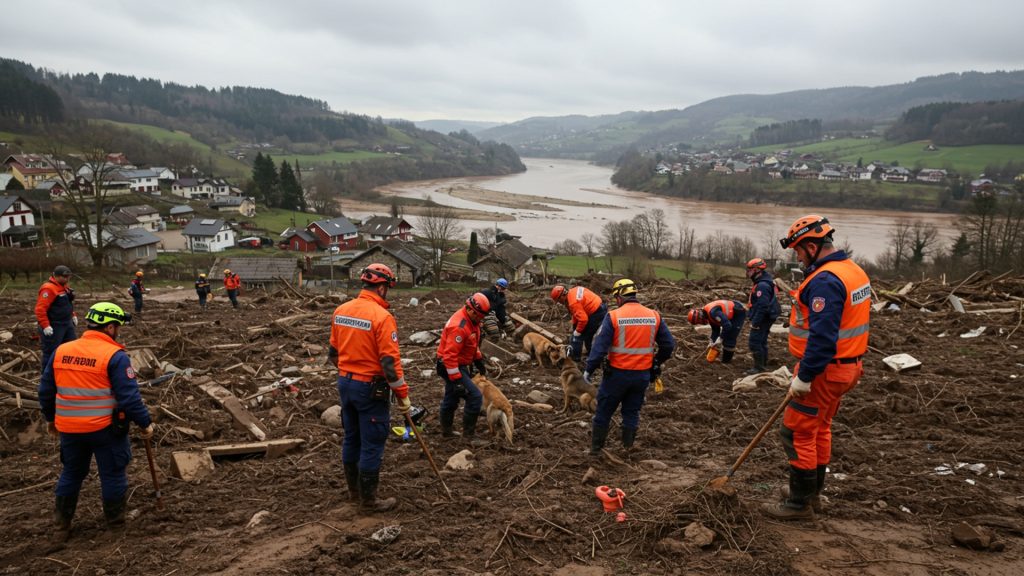Uttarakhand’s Uttarkashi faces a deepening crisis today as relentless natural forces have left a trail of destruction, prompting intensified rescue operations. The mountainous district is grappling with the aftermath of severe weather, leading to widespread landslides and flash floods that have isolated villages and left countless residents stranded. Emergency teams are now working tirelessly, battling difficult terrain and persistent challenges to reach those cut off, clear debris. provide urgent assistance. The immediate focus is on saving lives amidst the overwhelming scale of devastation, as authorities race against time to bring relief and stability back to the shattered communities.
Overwhelming Deluge Strikes Uttarkashi District
A sudden flash flood, possibly triggered by a cloudburst, hit Dharali village in Uttarakhand’s Uttarkashi district on August 5, 2025, causing widespread devastation. The powerful surge of water, mud. debris tore through the village and surrounding areas, including Harsil, engulfing homes, shops, hotels. infrastructure within moments. Visuals from the affected areas show entire buildings vanishing under the torrent. This catastrophic event has led to a significant loss of life and property in the region, which is a key stop on the pilgrimage route to Gangotri Dham.
Lives Lost and Many Still Missing
The immediate aftermath of the disaster saw confirmed fatalities and a high number of individuals reported missing. Initial reports indicated at least five people had died, with many more unaccounted for. As of August 12, 2025, the search was ongoing for 66 people, including 24 Nepali laborers, who were reported missing. Also, 42 others, among them nine army personnel, were still missing. The flash flood also swept away a part of an army camp in the region, leading to concerns for personnel stationed there. Local official Prashant Arya stated that a large part of Dharali village was engulfed in mud, with some areas buried under 15 meters of debris, enough to cover entire buildings.
Intense Rescue Operations Underway
In response to the widespread devastation, large-scale rescue and relief operations were swiftly launched and have intensified daily. Multiple agencies are working together, including the Army, Police, National Disaster Response Force (NDRF), State Disaster Response Force (SDRF). Indo-Tibetan Border Police (ITBP). Over 1,200 people have been rescued or evacuated from the affected areas, with Chief Minister Pushkar Singh Dhami confirming that about 1,308 individuals have been moved to safety. Air operations have been critical, with Chinook, Mi-17, ALH. Cheetah helicopters deployed to airlift stranded people from Dharali and Harsil to safer locations like Matli helipad. Ground teams are using heavy earthmoving equipment, tracker dogs. drones to search for those still missing under the debris.
Challenges Faced by Rescue Teams
Rescue efforts have been significantly hampered by continuous heavy rainfall and the difficult terrain. Initially, damaged roads and communication lines posed major obstacles, preventing rescue teams from reaching all affected areas. Mobile and electricity towers were swept away, necessitating the use of satellite phones for rescue teams to maintain contact. The heavy rain also turned dried mud into swampy terrain, making access challenging for ground teams and affecting search operations. Moreover, a temporary lake approximately 400-500 meters long formed upstream in Harsil, raising fears of further flooding if the natural dam were to breach. The India Meteorological Department (IMD) has issued warnings for continued heavy rainfall in the region through mid-August.
Government Response and Aid Measures
Chief Minister Pushkar Singh Dhami visited the affected areas, interacting with rescued individuals and holding review meetings with officials from the NDRF, SDRF. district administration. The government has announced financial assistance of ₹5 lakh for affected families. Relief supplies, including food packets, are being continuously dispatched to the impacted regions. Officials are also prioritizing the restoration of road connectivity, which has been severely disrupted by landslides and flash floods, with the Uttarkashi-Gangnani road completely blocked in some parts. All government and private schools, along with Anganwadi centers, in Uttarkashi district were ordered to remain closed due to the weather conditions.
Understanding the Region’s Vulnerability
The disaster in Uttarkashi highlights the increasing vulnerability of the Himalayan region to extreme weather events. Uttarakhand has experienced its most severe monsoon in four years, with 65% of monsoon days witnessing extreme weather events from June 1 to August 5, 2025. This marks a steady increase from previous years. Experts point to a combination of natural factors and human activities contributing to the amplified impact of such events. The steep terrain and narrow river valleys of the Himalayas can turn heavy rain into sudden, violent flash floods and landslides. Unregulated construction of roads, dams. buildings, along with deforestation, has disrupted natural drainage systems and eroded soil stability, making the slopes more prone to landslides. Scientists link the surge in extreme events to climate change, noting that warmer atmospheres hold and dump more moisture in short bursts.
Concerns Over Past Warnings and Ongoing Recovery
Amidst the ongoing crisis, a Bharatiya Janata Party leader, Ravindra Jugran, has raised concerns about the preparedness of the Disaster Management department. He alleged negligence and irresponsible functioning, citing a report from the Indian Institute of Remote Sensing (IIRS), an ISRO institute, sent a year prior. This report reportedly warned about artificial lakes in the upper regions of Dharali and Harsil that could trigger a disaster. Jugran questioned why the department denied receiving such a warning or did not conduct a site inspection, stating that ignoring the IIRS warning contributed to the current loss. Recovery efforts are progressing, with authorities continuing to work towards restoring full connectivity and ensuring the safe return of all individuals.

